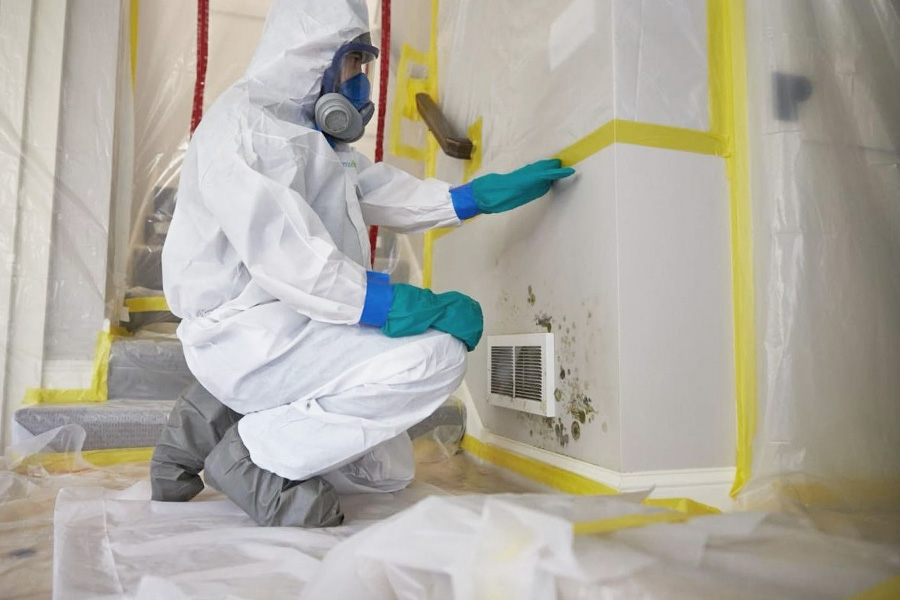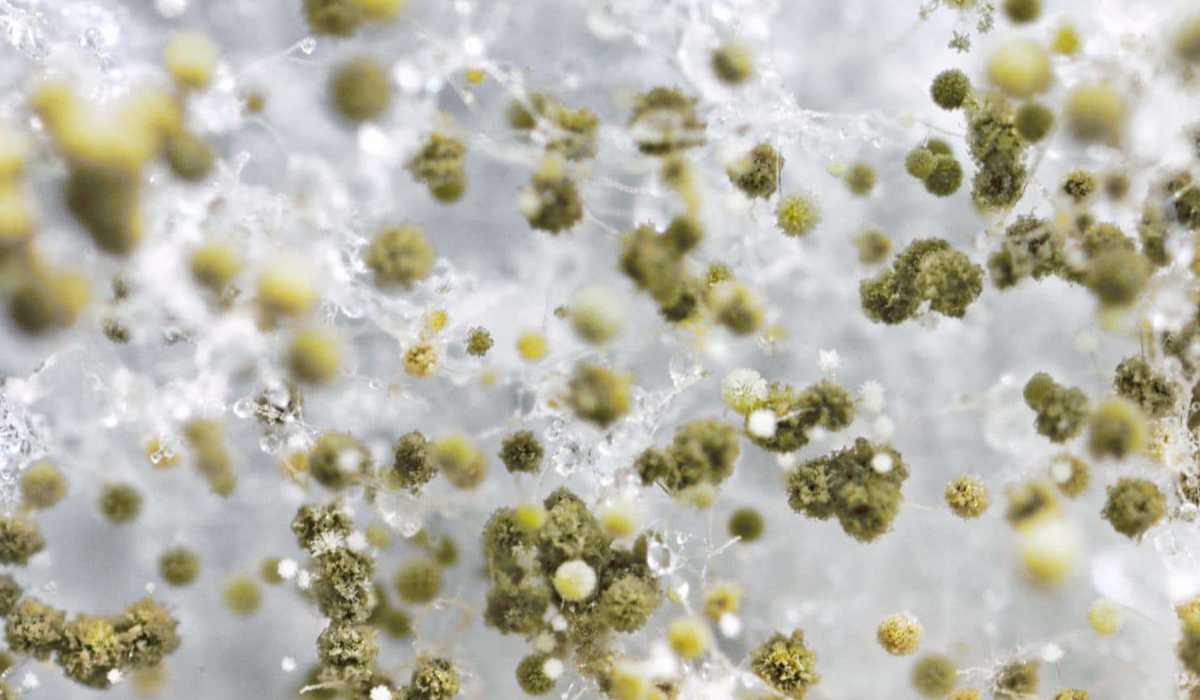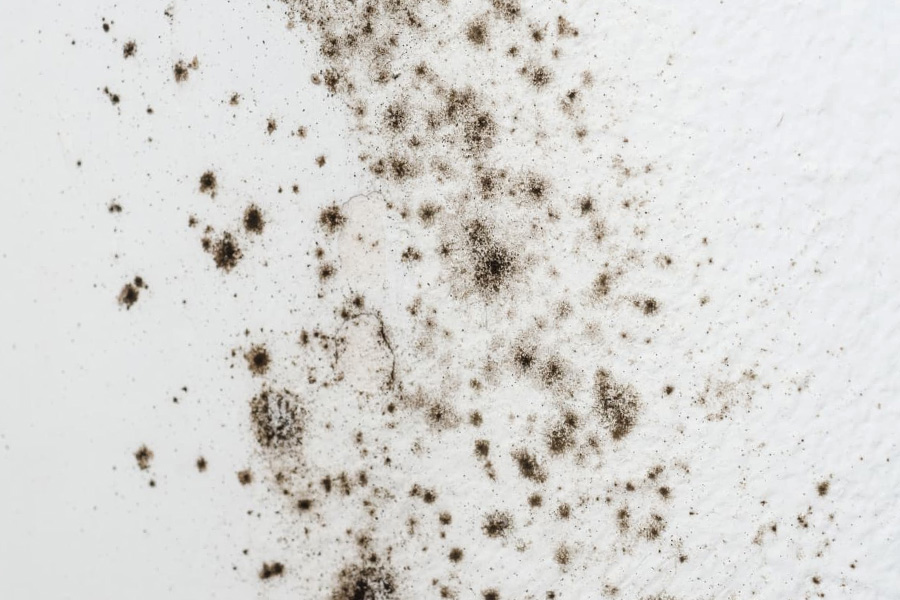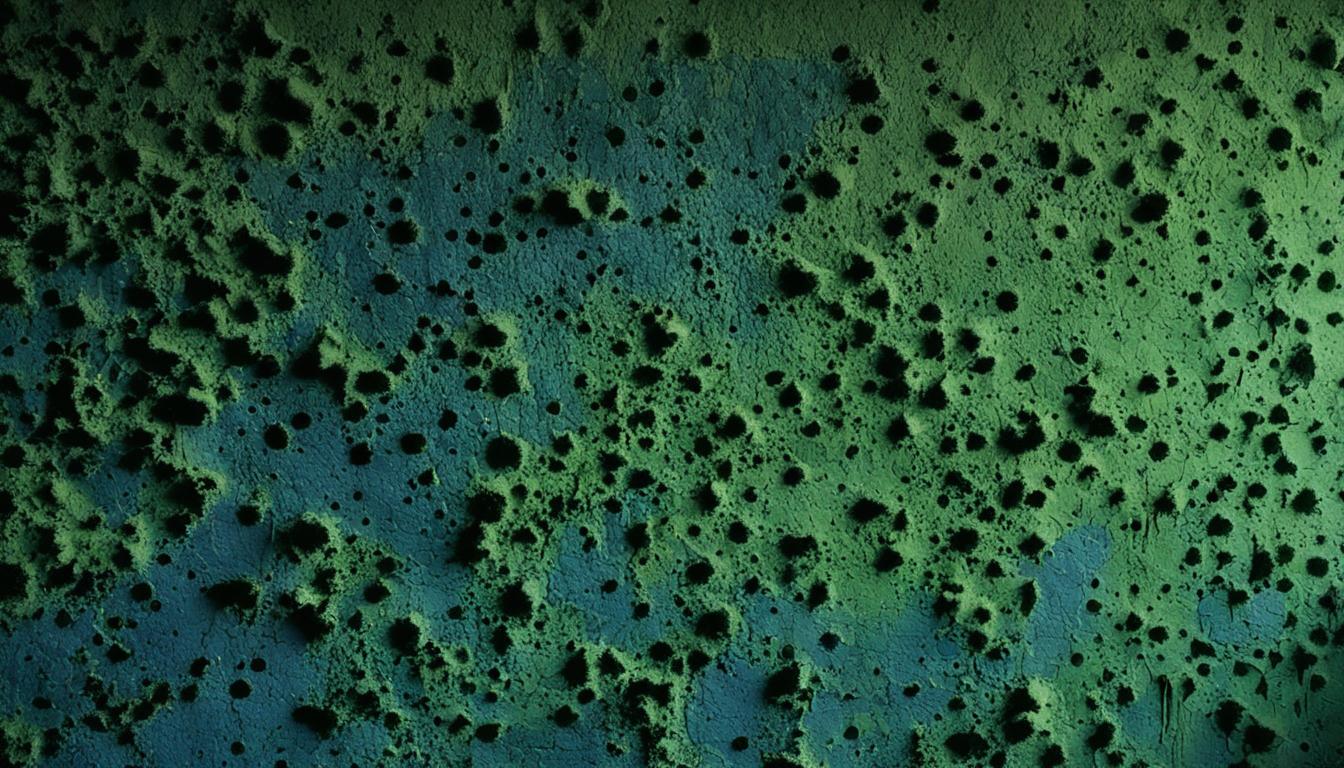
Understanding Penicillium Mold Risks & Remediation
Penicillium mold, like other types of mold, can have serious health implications and requires immediate attention. Not only can it cause respiratory issues and allergies, but it can also lead to potential infections in individuals with weak immune systems.
This section will provide necessary information on the risks associated with penicillium mold and suggest effective remediation strategies to ensure a healthy indoor environment. It is essential to detect and address the issue promptly for the safety of your family, employees, and pets.
Key Takeaways
- Penicillium mold can cause severe health implications if left untreated.
- Effective remediation strategies can help eliminate the prevalent risks of penicillium mold.
- Early detection and prompt measures can save occupants from severe health implications.
What is Penicillium Mold?
Penicillium mold is a type of fungi that belongs to the genus Penicillium and is commonly found in soil, decaying vegetation, and indoor environments such as homes, offices, and schools. This mold is characterized by its ability to spread and grow quickly, thanks to its ability to reproduce by producing spores that travel through the air.
Penicillium mold is often green or blue in color and may have a velvety or fuzzy texture. It is commonly found in damp or moist environments, such as basements, crawl spaces, and bathrooms, where it can grow on organic materials like damp wood, wallpaper, or ceiling tiles.
It is important to note that not all species of Penicillium mold are harmful to human health. However, certain types of Penicillium can produce mycotoxins that can cause health issues in people exposed to the mold.
In addition to indoor locations, Penicillium mold can also be found in various outdoor environments, including soil, decaying vegetation, and foods such as cheese and fruits. It can also contaminate indoor air quality if not addressed promptly and effectively.
Types of Penicillium Mold
Penicillium mold is a type of fungi that comes in various strains, each with its unique characteristics and health effects. In this section, we will discuss three common types of penicillium mold, their appearance, and health implications.
| Type of Penicillium Mold | Appearance | Health Effects |
|---|---|---|
| Penicillium chrysogenum | A velvet-like texture with bluish-green spores. | It can cause respiratory problems, infections, and allergy-like symptoms. |
| Penicillium expansum | Green-yellowish color with a fuzzy texture. | It can produce a toxin called patulin, which can cause gastrointestinal problems. |
| Penicillium griseofulvum | A greenish-blue color with a powdery texture. | It can cause infections, respiratory problems, and allergic reactions. |
It is important to note that the above strains of penicillium mold are not the only types in existence. In fact, there are over 200 known strains, each with their own unique characteristics, making it challenging to identify.
If you suspect your home or workplace has penicillium mold, it is best to seek professional help to conduct a thorough mold inspection and testing to identify the exact strain and its potential health risks.
Health Risks Associated with Penicillium Mold
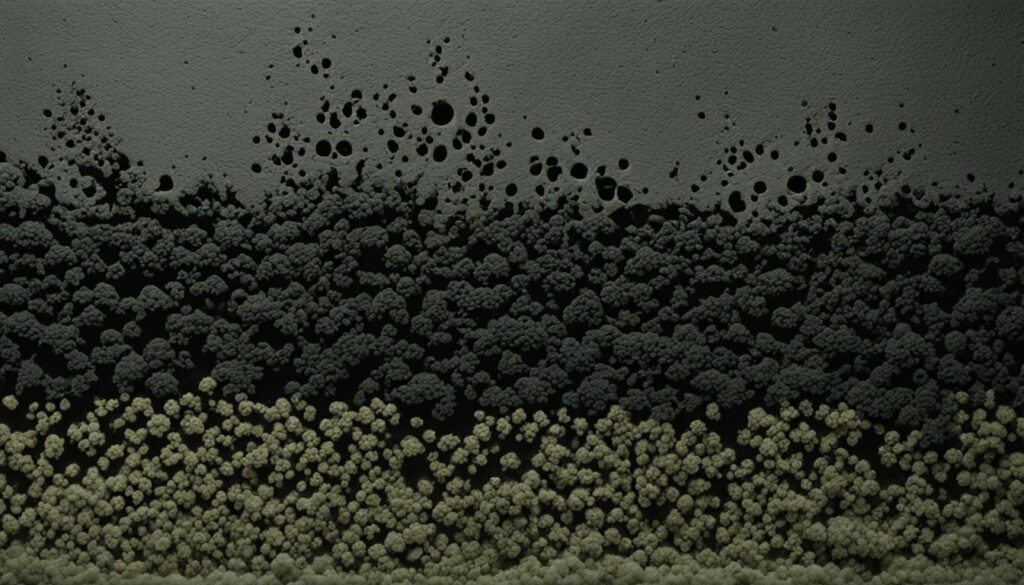
Exposure to penicillium mold can pose a risk to human health, particularly to those with weakened immune systems or pre-existing respiratory conditions. The mold can release harmful spores into the air, which when inhaled, can cause a range of negative health effects.
Respiratory issues, including coughing, wheezing, and shortness of breath, are common symptoms associated with exposure to penicillium mold. Prolonged exposure can lead to chronic respiratory problems, such as asthma. Additionally, individuals with allergies or hypersensitivity to mold may experience allergic reactions, including skin irritation, watery eyes, and congestion.
Penicillium mold can also pose a risk of infection, particularly for individuals with weakened immune systems. Inhalation of spores can lead to pulmonary mycosis, a lung infection that can cause serious health concerns. Furthermore, exposure to mycotoxins, toxic substances produced by certain molds including penicillium, can lead to a range of negative health outcomes.
How to Protect Yourself from Penicillium Mold Health Risks
Preventive measures such as controlling moisture and improving ventilation in the indoor environment are effective in limiting the growth and spread of penicillium mold. Professional mold testing and remediation services can help identify and address potential mold issues before they become a health risk.
“It’s crucial to take immediate action to address any signs of mold growth and ensure that your indoor environment remains safe and healthy.”
Regularly inspecting and maintaining the property is also important in preventing mold growth and ensuring a healthy living or working space. If you experience any symptoms that may be related to exposure to mold, consult with a healthcare professional immediately.
Identifying Penicillium Mold
Penicillium mold can be identified in various ways. The most common signs of penicillium mold growth are the green or blue-green color on surfaces, often accompanied by a fuzzy or powdery texture. Musty odors are also a telltale sign of mold growth. However, it is important to note that some strains of penicillium mold have no distinct smell.
To accurately identify penicillium mold and distinguish it from other molds, it is recommended to perform professional mold testing. This involves taking samples of mold from various locations and surfaces in the property and sending them to a lab for analysis. The lab will determine the type of mold present and provide recommendations for effective remediation strategies.
It is important to avoid direct contact and inhalation of mold spores during identification or cleaning processes, as exposure can lead to various health risks.
Prevention of Penicillium Mold
To prevent penicillium mold growth, it is important to control moisture levels in your home or building. Repair any leaks or water damage promptly and ensure proper ventilation in areas prone to high humidity, like bathrooms and kitchens. Regularly inspect and maintain the property to identify and address issues early on. Additionally, using a dehumidifier and keeping indoor humidity levels below 60% can help prevent mold growth.
Did you know? A study conducted by the Institute of Medicine found that damp indoor environments with mold are associated with respiratory symptoms, such as coughing, wheezing, and asthma exacerbation.
Implementing these prevention strategies can significantly reduce the risk of penicillium mold growth in your home or building. When mold growth is widespread, consider hiring a professional mold remediation service for effective and safe removal.
Penicillium Mold in Homes and Buildings
Penicillium mold can be found in many areas of homes and buildings, particularly in spaces with high humidity levels. Basements, bathrooms, and areas affected by water damage are common locations where penicillium mold can thrive.
In addition, penicillium mold can grow on water-damaged building materials, such as drywall, insulation, and carpet, making it essential to address any moisture issues promptly to prevent its growth.
To effectively prevent and control penicillium mold growth, it is important to maintain proper ventilation, regulate indoor humidity levels, and address any water damage promptly. Regularly inspecting and maintaining the property can also help identify and address any potential penicillium mold growth.
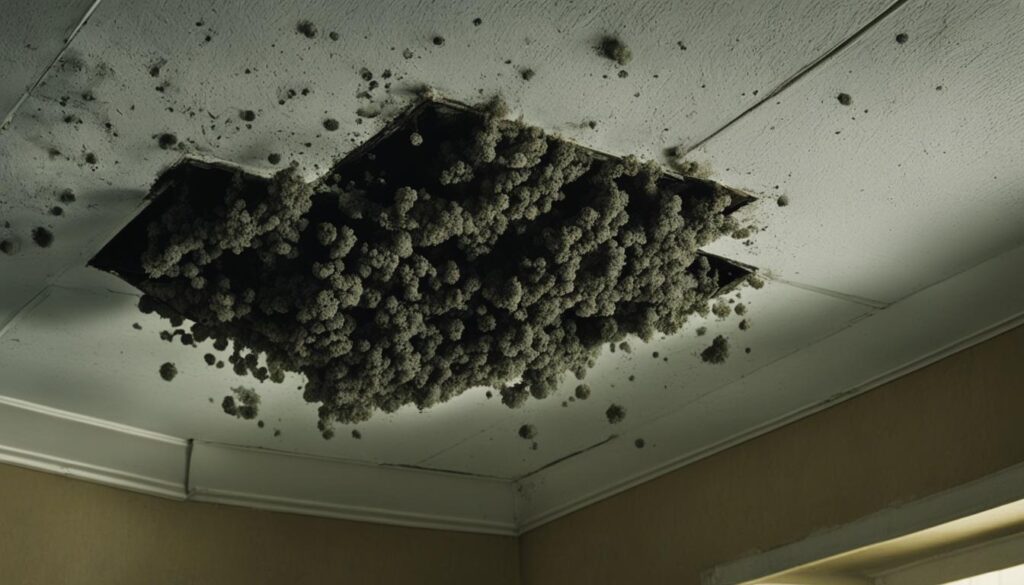
“Penicillium mold growth can cause serious indoor air quality issues and health risks. It is essential to identify and address any potential sources of moisture and perform effective remediation strategies to ensure a healthy indoor environment.”
Penicillium Mold in Food
Penicillium mold is a common occurrence in various food products, including cheese and fruits. Though this type of mold is often harmless and even beneficial, certain strains can produce mycotoxins that pose health risks to humans. Mycotoxins are toxic chemicals produced by molds that can cause various adverse effects, such as nausea and vomiting, respiratory issues, and in severe cases, organ damage.
Certain types of cheese, such as blue cheese and Roquefort, are intentionally inoculated with penicillium mold during production to achieve their distinctive taste and texture. However, other types of cheese can be contaminated with penicillium mold accidentally during storage or transportation, leading to spoilage and potential health risks.
Fruits such as grapes and apples can also be affected by penicillium mold, leading to decay and potential contamination of other fruits stored nearby. While it is not always possible to detect penicillium mold by visual inspection alone, an earthy or musty odor can be a sign of mold growth.
To minimize the risk of penicillium mold contamination in food, it is crucial to purchase fresh, high-quality products from reputable sources. Proper storage and temperature control can also help prevent mold growth. If mold is detected on any food product, it is best to discard it to avoid potential health hazards.
Examples of Penicillium Mold in Food
| Food Product | Type of Penicillium Mold |
|---|---|
| Blue Cheese | Penicillium roqueforti |
| Brie Cheese | Penicillium candidum |
| Grapes | Penicillium expansum |
| Apples | Penicillium digitatum |
Penicillium Mold in Indoor Air
When penicillium mold grows indoors, it can release spores that become airborne and potentially contaminate indoor air quality. Breathing in these mold spores can cause a range of health problems, including respiratory issues, allergies, and even infections in some cases.
To prevent the inhalation of mold spores, it’s important to ensure proper ventilation in indoor spaces where mold could be present. This includes increasing airflow to affected areas and using air filters to trap mold spores.
If you suspect that penicillium mold is present in your indoor air, it’s important to have a professional mold inspection conducted to verify the type of mold and its severity. Professional mold remediation services can then be employed to remove the mold from your indoor environment and ensure that the air quality is restored to a safe level.
Effective Penicillium Mold Removal Strategies
If you’ve identified penicillium mold in your home or building, it’s crucial to remove it promptly to prevent potential health issues. Here are some effective penicillium mold removal strategies:
Hiring Professional Mold Remediation Services
For larger areas affected by penicillium mold, it’s best to hire professional mold remediation services. Trained professionals use specialized equipment and techniques to remove the mold safely and effectively, reducing the risk of further contamination. They can also identify the root cause of the mold growth and provide recommendations for preventing future outbreaks.
DIY Techniques for Smaller Affected Areas
For smaller areas affected by penicillium mold, you may be able to remove it yourself using simple DIY techniques. Wear protective gear, such as gloves and a face mask, to prevent exposure to mold spores, and follow these steps:
- Identify and fix the source of moisture that caused the mold to grow.
- Clean the affected area using a solution of water and detergent or a commercial mold cleaner. Be sure to dry the area thoroughly afterward.
- Use a HEPA vacuum to remove any remaining mold spores and debris.
- Dispose of any materials that cannot be cleaned, such as porous materials like carpets and drywall.
Remember, if the affected area is larger than 10 square feet, or if you’re unsure about how to safely handle the mold removal process, it’s best to consult with a professional.
“Effective penicillium mold removal requires proper identification, protective gear, and thorough cleaning techniques.”
Conclusion
Penicillium mold can pose various health risks, including respiratory issues, allergies, and infections. It can be found in numerous locations, from homes and buildings to food products. Identifying and preventing its growth is crucial to maintaining a safe indoor environment.
Effective penicillium mold removal strategies should be employed as soon as possible to ensure remediation is successful. This can involve hiring professional mold remediation services or utilizing DIY techniques for smaller affected areas. Taking prompt action is critical to minimizing the risk of exposure to penicillium mold and maintaining optimal health.
Overall, awareness of penicillium mold risks and effective remediation techniques are essential for creating a safe and healthy indoor environment for yourself and others. If you suspect mold growth in your property or have any concerns, it is recommended that you seek professional advice for proper diagnosis and treatment.
FAQ
What is penicillium mold?
Penicillium mold is a type of fungus that can grow indoors and outdoors. It is commonly found in damp and humid environments such as basements, bathrooms, and areas with water damage.
What are the types of penicillium mold?
There are several types of penicillium mold, including Penicillium chrysogenum, Penicillium notatum, and Penicillium roqueforti. Each type has its own characteristics and potential health effects.
What are the health risks associated with penicillium mold?
Exposure to penicillium mold can lead to respiratory issues, allergies, and potential infections. Individuals with weakened immune systems are particularly vulnerable to the health risks posed by this mold.
How can penicillium mold be identified?
Penicillium mold can be identified through its characteristic blue or green appearance, musty odor, and the presence of visible mold growth in damp areas. Professional mold testing can also be conducted to accurately identify penicillium mold.
How can penicillium mold growth be prevented?
To prevent penicillium mold growth, it is important to control moisture levels by fixing leaks, improving ventilation, and using dehumidifiers in damp areas. Regularly inspecting and maintaining the property can also help identify and address mold growth early.
Where can penicillium mold be found in homes and buildings?
Penicillium mold can be found in areas of homes and buildings that are prone to moisture and water damage, such as basements, bathrooms, kitchens, and areas with poor ventilation.
Is penicillium mold commonly found in food?
Yes, penicillium mold is often found in various food products, including cheese, fruits, and bread. While some types of penicillium mold are safe for consumption, others can produce harmful mycotoxins and should be avoided.
Can penicillium mold contaminate indoor air?
Yes, penicillium mold can become airborne and contaminate indoor air quality. Breathing in mold spores from the air can lead to respiratory issues and allergies, especially for individuals with sensitivities or compromised immune systems.
What are effective strategies for penicillium mold removal?
Effective penicillium mold removal strategies include hiring professional mold remediation services for extensive infestations and using DIY techniques such as scrubbing affected surfaces with a bleach solution for smaller affected areas. It is important to address mold removal promptly and thoroughly to prevent further growth and potential health risks.

